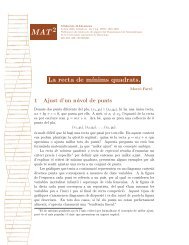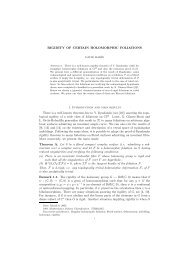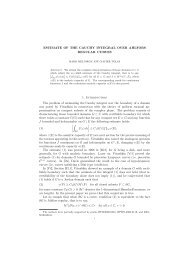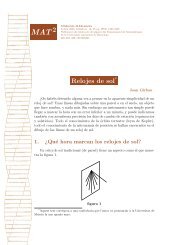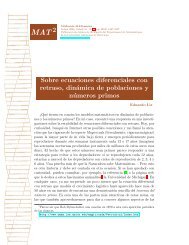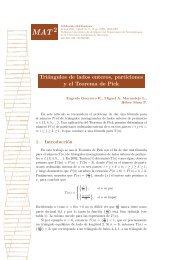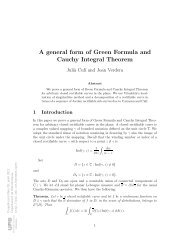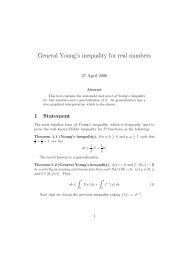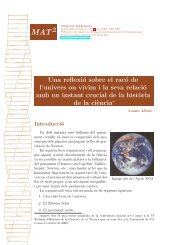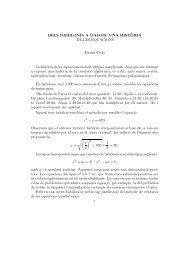<strong>IWASAWA</strong> <strong>THEORY</strong> <strong>OVER</strong> <strong>FUNCTION</strong> <strong>FIELDS</strong> 14starting point for Iwasawa himself (see [47] for a quick summary). The goal of this section isto say something on what is known about Iwasawa Main Conjectures for class groups in oursetting.5.1. Crew’s work. A version of the Iwasawa Main Conjecture over global function fields wasproved by R. Crew in [13]. His main tools are geometric: so he considers an affine curve X overa finite field of characteristic p (in the language of the present paper, F is the function field ofX) and a p-adic character of π 1 (X), that is, a continuous homomorphism ρ: π 1 (X) −→ R ∗ ,where R is a complete local noetherian ring of mixed characteristic, with maximal ideal m(notice that the Iwasawa algebras Λ d introduced in section 2.1 above are rings of this kind).To such a ρ are attached H(ρ, x) ∈ R[x] (the characteristic polynomial of the cohomologyof a certain étale sheaf - see [12] for more explanation) and the L-function L(ρ, x) ∈ R[[x]].The main theorem of [13] proves, by means of étale and crystalline cohomology, that theratio L(ρ, x)/H(ρ, x) is a unit in the m-adic completion of R[x]. An account of the geometricsignificance of this result (together with some of the necessary background) is provided byCrew himself in [12]; in [13, §3] he shows the following application to Iwasawa theory. Letting(in our notations) R be the Iwasawa algebra Λ(F d ), the special value L(ρ, 1) can be seen to bea Stickelberger element (the definition will be recalled in section 5.3 below). As for H(ρ, 1),[12, Proposition 3.1] implies that it generates the characteristic ideal of the torsion Λ d -modulelim←A(L) ∨ , L varying among finite subextensions of F d /F 2 . The Iwasawa Main Conjecturefollows.Crew’s cohomological techniques are quite sophisticated. A more elementary approach wassuggested by Kueh, Lai and Tan in [28] (and refined, with Burns’s contribution and differentcohomological tools, in [8]). In the next two sections we will give a brief account of thisapproach (and its consequences) in a particularly simple setting, related to Drinfeld-Hayescyclotomic extensions (which will be the main topic of section 6).5.2. Characteristic ideals for class groups. In this section (which somehow parallelssection 3) we describe an algebraic object which can be associated to the inverse limit of classgroups in a Z N p -extension F of a global function field F . Since our first goal is to use this“algebraic L-function” for the cyclotomic extension which will appear in section 6.1, we makethe following simplifying assumption.Assumption 5.1. There is only one ramified prime in F/F (call it p) and it is totally ramified(in particular this implies that F is disjoint from F arit ).We shall use some ideas of [27] which, in our setting, provide a quite elementary approachto the problem. We maintain the notations of section 3: F/F is a Z N p -extension with Galoisgroup Γ and associated Iwasawa algebra Λ with augmentation ideal I. For any d ≥ 0 let F dbe a Z d p-extension of F contained in F, taken so that ⋃ F d = F.For any finite extension L/F let M(L) be the p-adic completion of the group of divisorclasses Div(L)/P L of L, i.e.,M(L) := (L ∗ \I L /Π v O ∗ v) ⊗ Z pwhere I L is the group of ideles of L. As before, when L/F is an infinite extension, we putM(L) := lim←M(K) as K runs among finite subextensions of L/F (the limit being taken with2 Note that in [12] our A(L)’s appear as Picard groups, so the natural functoriality yields A(L) → A(L ′ ) ifL ⊂ L ′ - that is, arrows are opposite to the ones we consider in this paper: hence Crew takes Pontrjagin dualsand we don’t.
<strong>IWASAWA</strong> <strong>THEORY</strong> <strong>OVER</strong> <strong>FUNCTION</strong> <strong>FIELDS</strong> 15respect to norm maps). For two finite extensions L ⊃ L ′ ⊃ F , the degree maps deg L anddeg L ′ fit into the commutative diagram (with exact rows)(5.1) A(L) M(L)deg L Z pN L L ′A(L ′ ) N L L ′ M(L ′ )deg L ′ Z p ,where N L L ′ denotes the norm and the vertical map on the right is multiplication by [F L : F L ′](the degree of the extension between the fields of constants). For an infinite extension L/Fcontained in F, taking projective limits (and recalling Assumption 5.1 above), one gets anexact sequence(5.2) A(L) M(L)deg L Z p .Remark 5.2. If one allows non-geometric extensions then the deg L map above becomes thezero map exactly when the Z p -extension F arit is contained in L.It is well known that M(F d ) is a finitely generated torsion Λ(F d )-module (see e.g. [19,Theorem 1]), so the same holds for A(F d ) as well. Moreover take any Z d p-extension F d of Fcontained in F: since our extension F/F is totally ramified at the prime p, for any F d−1 ⊂ F done has(5.3) M(F d )/I F dF d−1M(F d ) ≃ M(F d−1 )(see for example [48, Lemma 13.15]). As in Section 3, to ease notations we will often erasethe F from the indices (for example I F dF d−1will be denoted by Id−1 d ), hoping that no confusionwill arise. Consider the following diagram(5.4) A(F d ) M(F d ) deg Z pγ−1γ−1A(F d ) γ−1 M(F d ) deg Z p(where 〈γ〉 = Gal(F d /F d−1 ) =: Γ d d−1; note also that the vertical map on the right is 0) andits snake lemma sequence(5.5) A(F d ) Γd d−1 M(F d ) Γd d−1deg Z pdegZ p M(F d )/Id−1 d M(F d) A(F d )/Id−1 d A(F d) .For d ≥ 2 the Λ d -module Z p is pseudo-null, hence (5.2) yields Ch Λd (M(F d )) = Ch Λd (A(F d )),and, using (5.3) and (5.5), one finds (for d ≥ 3)(5.6)Ch Λd−1 (A(F d )/I d d−1 A(F d)) = Ch Λd−1 (M(F d )/I d d−1 M(F d))= Ch Λd−1 (M(F d−1 )) = Ch Λd−1 (A(F d−1 ))(where all the modules involved are Λ d−1 -torsion modules).Let(5.7) N(F d ) ↩→ A(F d )ι−→ E(F d ) ↠ R(F d )



